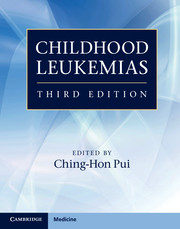Book contents
- Frontmatter
- Contents
- List of contributors
- Preface
- Section 1 History and general issues
- Section 2 Cell biology and pathobiology
- Section 3 Evaluation and treatment
- 12 Pharmacokinetic, pharmacodynamic, and pharmacogenetic considerations
- 13 Acute lymphoblastic leukemia
- 14 Relapsed acute lymphoblastic leukemia
- 15 B-cell acute lymphoblastic leukemia and Burkitt lymphoma
- 16 Acute myeloid leukemia
- 17 Relapsed acute myeloid leukemia
- 18 Myelodysplastic syndrome
- 19 Chronic myeloproliferative disorders
- 20 Leukemias in patients with Down syndrome
- 21 Treatment of adolescents and young adults with acute lymphoblastic leukemia
- 22 Hematopoietic stem cell and natural killer cell transplantation
- 23 Treatment of acute leukemia in countries with limited resources
- 24 Antibody-targeted therapy
- 25 Adoptive cellular immunotherapy
- 26 Gene transfer: methods and applications
- 27 Development therapeutics
- 28 Minimal residual disease
- Section 4 Complications and supportive care
- Index
- Plate Section
- References
20 - Leukemias in patients with Down syndrome
from Section 3 - Evaluation and treatment
Published online by Cambridge University Press: 05 April 2013
- Frontmatter
- Contents
- List of contributors
- Preface
- Section 1 History and general issues
- Section 2 Cell biology and pathobiology
- Section 3 Evaluation and treatment
- 12 Pharmacokinetic, pharmacodynamic, and pharmacogenetic considerations
- 13 Acute lymphoblastic leukemia
- 14 Relapsed acute lymphoblastic leukemia
- 15 B-cell acute lymphoblastic leukemia and Burkitt lymphoma
- 16 Acute myeloid leukemia
- 17 Relapsed acute myeloid leukemia
- 18 Myelodysplastic syndrome
- 19 Chronic myeloproliferative disorders
- 20 Leukemias in patients with Down syndrome
- 21 Treatment of adolescents and young adults with acute lymphoblastic leukemia
- 22 Hematopoietic stem cell and natural killer cell transplantation
- 23 Treatment of acute leukemia in countries with limited resources
- 24 Antibody-targeted therapy
- 25 Adoptive cellular immunotherapy
- 26 Gene transfer: methods and applications
- 27 Development therapeutics
- 28 Minimal residual disease
- Section 4 Complications and supportive care
- Index
- Plate Section
- References
Summary
Introduction
In 1866, the English physician John Langdon Down published the essay “Observations on an ethnic classification of idiots,” in which he described common features of children with cognitive impairments. Although not the first person to describe the condition, Down's essay led to his name being linked to the genetic disorder now known as Down syndrome (DS). Shortly after the development of chromosome karyotyping, Dr. Jerome Lejeune and colleagues identified in 1959 that the underlying genetic basis for Down syndrome was the presence of three copies of chromosome 21 (trisomy 21). In the span of approximately 150 years since Down's essay, DS and its associated medical conditions, including learning disabilities, congenital heart disease, and early-onset Alzheimer disease, has become one of the most studied genetic conditions, with over 19 000 publications listed on PubMed. It is the most common chromosomal abnormality in the USA, occurring in 1 of every 800 to 1000 live births, and approximately 40 000 individuals with DS are currently living in the USA.
Following the first description of leukemia in a DS child in 1930, subsequent case reports suggested that DS children had an increased risk of developing leukemia, which was confirmed in a 1950s national survey. It is estimated that DS children have a 10- to 20-fold increased risk of developing both acute lymphoblastic leukemia (ALL) and acute myeloid leukemia (AML) compared with non-DS children. Although one analysis suggested that this increased risk extends into adulthood, more recent data indicate that the increased risk for acute leukemia in DS is limited to the first three decades of life.
- Type
- Chapter
- Information
- Childhood Leukemias , pp. 503 - 519Publisher: Cambridge University PressPrint publication year: 2012



